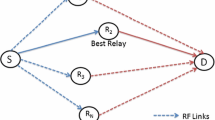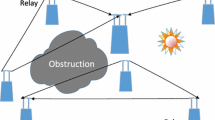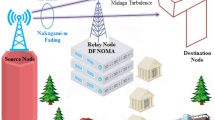Abstract
In this paper, we derive the Symbol Error Probability (SEP) of Round Robin (RRS), Centralized (CRS) and Distributed Relay Selection (DRS) techniques for Free Space Optical communications. RRS consists to randomly select a node as relay with equal probability. It does not consider the SNR value for relay selection. In CRS, the SNRs of different relays are sent to a Central Node (CN) for detecting the relay with highest SNR. The CN selects the best relay with largest SNR. We propose a new DRS where each relay is allowed to transmit only when its SNR is higher than a given threshold T. The threshold T is optimized with the Gradient algorithm to guarantee the lowest SEP. The suggested DRS with optimal threshold allows close performance to CRS and better performance than RRS. DRS is less complex than CRS since no signalization is needed.








Similar content being viewed by others
References
Dabiri, M. T., & Sadough, S. M. S. (2018). Performance analysis of all-optical amplify and forward relaying over log-normal FSO channels. IEEE/OSA Journal of Optical Communications and Networking, 10(2), 79–89.
Vu, M. Q., Nguyen, N. T. T., Vu, M. B., Phan, H. T. T., Pham, H. T. T., & Dang, N. T. (2017). HAP-based FSO system using all-optical detect-amplify-and-forward relaying and coherent detection receiver. In 2017 4th NAFOSTED Conference on Information and Computer Science, pp. 120–125.
Alheadary, W. G., Park, K. -H., & Alouini, M. -S. (2017). BER analysis of multi-hop heterodyne FSO systems with fixed gain relays over general Malaga turbulence channels. In 2017 13th International Wireless Communications and Mobile Computing Conference (IWCMC) 2017, pp. 1172–1177.
Zedini, E., Soury, H., Alouini, M. -S. (2016). Outage probability of dual-hop FSO fixed gain relay transmission systems. In 2016 IEEE 27th Annual International Symposium on Personal, Indoor, and Mobile Radio Communications (PIMRC) 2016, pp. 1–6.
Boluda-Ruiz, R., García-Zambrana, A., Castillo-Vázquez, B., & Castillo-Vázquez, C. (2016). Ergodic capacity analysis of decode-and-forward relay-assisted FSO systems over alpha-mu fading channels considering pointing errors. IEEE Photonics Journal, 8(1), 1–11.
Al-Ebraheemy, O. M. S., Salhab, A. M., Chaaban, A., Zummo, S. A., & Alouini, M. -S. (2017). Precise outage analysis of mixed RF/unified-FSO DF relaying with HD and 2 IM-DD channel models. In 2017 13th International Wireless Communications and Mobile Computing Conference (IWCMC), 2017, pp. 1184–1189.
Balti, E., Guizani, M., Hamdaoui, B., & Maalej, Y. (2016). Partial relay selection for hybrid RF/FSO systems with hardware impairments. In 2016 IEEE Global Communications Conference (GLOBECOM), 2016, pp. 1–6.
Sharma, P. K., Bansal, A., Garg, P., Tsiftsis, T., & Barrios, R. (2017). Relayed FSO communication with aperture averaging receivers and misalignment errors. IET Communications, 11(1), 45–52.
Boluda-Ruiz, R., García-Zambrana, A., Castillo-Vázquez, B., & Castillo-Vázquez, C. (2016). MISO relay-assisted FSO systems over gamma–gamma fading channels with pointing errors. IEEE Photonics Technology Letters, 28(3), 229–232.
Abou-Rjeily, C., & Noun, Z. (2016). Impact of inter-relay co-operation on the performance of FSO systems with any number of relays. IEEE Transactions on Wireless Communications, 15(6), 3796–3809.
Trinh, P. V., Thang, T. C., & Pham, A. T. (2016). Two-way all-optical AF relaying FSO systems over Malaga (M) channels with pointing errors. In 2016 IEEE International Conference on Communications (ICC), 2016, pp. 1–7.
Yang, L., Alouini, M. -S., & Ansari, I. S. (2018). Asymptotic performance analysis of two-way relaying FSO networks with nonzero boresight pointing errors over double-generalized gamma fading channels. IEEE Transactions on Vehicular Technology. (Early Access) pp. 1–1.
Al-Qahtani, F. S., Abd, E.-M., Ahmed, H., Ansari, I. S., Radaydeh, R. M., & Zummo, S. A. (2017). Outage analysis of mixed underlay cognitive RF MIMO and FSO relaying with interference reduction. IEEE Photonics Journal, 9(2), 1–22.
Kong, L., Xu, W., Zhang, H., & Zhao, C. (2016). Mixed RF/FSO two-way relaying system under generalized FSO channel with pointing error. In: 2016 8th International Conference on Ubiquitous and Future Networks (ICUFN), 2016, pp. 264–269.
Abd E. -M., Ahmed H., Salhab, A. M., Zummo, S. A., & Alouini, M.-S. (2016). Enhancing physical layer security of multiuser SIMO mixed RF/FSO relay networks with multi-eavesdroppers. In 2016 IEEE Globecom Workshops (GC Wkshps), 2016.
Abdo, A. M. A., Zhao, X., Zhang, R., Zhou, Z., Jianhua Z., Yu, Z., & Memon, I. (2018). MU-MIMO downlink capacity analysis and optimum code weight vector design for 5G big data massive antenna millimeter wave communication. Wireless Communications and Mobile Computing, 2018, 7138232.
Mangi, F. A., Xiao, S., Yao, Z., Memon, I., & Kakepoto, G. F. (2018). Dual-band asymmetric circular polariser based on fission transmission of linearly polarised wave. Antennas and Propagation IET Microwaves, 12, 1414–1419.
Hasan, M. K., Ismail, A. F., Islam, S., Hashim, W., Ahmed, M. M., & Memon, I. (2018). A novel HGBBDSA-CTI approach for subcarrier allocation in heterogeneous network. Telecommunication Systems, 70(2), 245–262.
Memon, I., Chen, L., Arain, Q. A., Memon, H., & Chen, G. (2018). Pseudonym changing strategy with multiple mix zones for trajectory privacy protection in road networks. International Journal of Communication Systems, 31(1), e3437.
Peng, Siming, Liu, Aijun, Song, Li, Memon, Imran, & Wang, Heng. (2018). Spectral efficiency maximization for deliberate clipping-based multicarrier faster-than-Nyquist signaling. IEEE Access, 6, 13617–13623.
Memon, I. (2018). Distance and clustering based energy efficient pseudonyms changing strategy over road network. International Journal of Communication Systems, 31, e3704.
Memon, I., Chen, L., Majid, A., Lv, M., Hussain, Ibrar, & Chen, Gencai. (2015). Travel recommendation using geo-tagged photos in social media for tourist. Wireless Personal Communications, 80(4), 1347–1362.
Mangi, F. A., Xiao, S., Ghulam A. M., Jamro, D. A., Memon, I., & Kakepoto, G. F. (2016). Multiband circular polarizer based on fission transmission of linearly polarized wave for X-band applications. Journal of Electrical and Computer Engineering, 2016, 4293089.
Arain, Q. A., Memon, H., Memon, I., Memon, M. H., Shaikh, Riaz Ahmed, & Mangi, Farman Ali. (2017). Intelligent travel information platform based on location base services to predict user travel behavior from user-generated GPS traces. International Journal of Computers and Applications, 39(3), 155–168.
Zhao, X., Abdo, A. M. A., Chen, X., Geng, S., Zhang, Jianhua, & Memon, Imran. (2018). Dimension reduction of channel correlation matrix using CUR-decomposition technique for 3-D massive antenna system. IEEE Access, 6, 3031–3039.
Jamro, D. A., Hong, J. B., Mamadou, H., Mangi, F. A., & Memon, I. (2016). Triangular antenna with novel techniques for RCS reduction applications, wireless communications, networking and applications (pp. 775–782). New Delhi: Springer.
Arain, Q. A., Deng, Z. L., Memon, I., Zubedi, A., & Mangi, Farman Ali. (2017). Location privacy with dynamic pseudonym-based multiple mix-zones generation over road networks. Wireless Personal Communications, 97(3), 3645–3671.
Anguita, J. A., Djordjevic, I. B., Neifeld, M. A., & Vasic, B. V. (2005). Shannon capacities and error-correction codes for optical atmospheric turbulent channels. Journal Optical Networking, 4, 586–601.
Sandalidis, H., Tsiftsis, T., Karagiannidis, G., & Uysal, M. (2008). BER performance of FSO links over strong atmospheric turbulence channels with pointing errors. IEEE Communications Letters, 12(1), 44–46.
Park, J., Lee, E., & Yoon, G. (2011). Average bit-error rate of the Alamouti scheme in Gamma–Gamma fading channels. IEEE Photonics Technology Letters, 23(4), 269–271.
Al-Ahmadi, S., & Yanikomeroglu, H. (2010). On the approximation of the generalized-K distribution by a Gamma distribution for modeling composite fading channels. IEEE Transactions on Wireless Communications, 9(2), 706–713.
Simon, M. K., & Alouini, M. S. (2005). Digital communications over fading channels (2nd ed.). Hoboken: Wiley.
Author information
Authors and Affiliations
Corresponding author
Additional information
Publisher's Note
Springer Nature remains neutral with regard to jurisdictional claims in published maps and institutional affiliations.
Appendices
Appendix A : SEP of a Direct Link
For M-PAM modulation, the SEP of the direct link for a given SNR \(\gamma \) is written as
The average SEP of the S-\( D_{i}\) link is written as
We have [32]
We deduce
Let \(M_{\Gamma _{SD_{i}}}(s)\) be the Moment Generating Function (MGF) of SNR \(\Gamma _{SD_{i}}\)
We deduce from (26) and (27) that
Using the Laplace Transform (LT) table, the MGF of SNR \(\Gamma _{SD_{i}}\) is written as
\(\overline{\Gamma }_{SD_{i}}\) is the average SNR between S and \(D_i\).
Using (28) and (29), we can write
This integral can be solved in closed form [32]
where \(_2F_1(.,.,.,.)\) is the hypergeometric function.
Appendix B : SEP of AF Relayed Link
The SNR of AF relaying is equal to
The SNR of AF relaying can be upper bounded and lower bounded by
1.1 B.1 Lower Bound of SEP
The CDF of \(\Gamma _{SD_{j}D_{i}}^{up}\) is expressed as
Assuming that the SNR of first and second hops are independent, we can write
The PDF of SNR of relaying link is deduced by a simple derivative of the CDF
A LT of the PDF of SNR provides the MGF [32]
where \(_{2}F_{1}\) is the Gauss’ Hypergeometric function.
The SEP can be lower bounded by
1.2 B.2 Upper Bound of SEP
Let \(U=\Gamma _{S,D_{j},D_i}^{low}\) and \(V=\Gamma _{S,D_{j},D_i}^{up}\). We have U=V/2.
We deduce
\(P_U(u)=P_V(2u)\),
\(p_U(u)=2p_V(2u)\),
\(M_U(s)=E(e^{-sU})=M_V(s/2)\),
The SEP can be upper bounded by
where \(M_{\Gamma _{SD_{j}D_{i}}^{up}}(s)\) provided in (37).
Appendix C : SEP of Combined Direct and Relayed Links
The SNR at \(D_{i}\) when the relayed and direct links are combined is written as
The PDF of \(\Gamma _{coop}\) is equal to
Therefore, the MGF of \(\Gamma _{coop}\) is written as
Using lower and upper bounds of SNR (33), we can write
Therefore, the SEP is upper bounded by
The SEP is lower bounded by
Appendix D
We have
Rights and permissions
About this article
Cite this article
Ben Halima, N., Boujemâa, H. Round Robin, Centralized and Distributed Relay Selection for Free Space Optical Communications. Wireless Pers Commun 108, 51–66 (2019). https://doi.org/10.1007/s11277-019-06387-x
Published:
Issue Date:
DOI: https://doi.org/10.1007/s11277-019-06387-x




